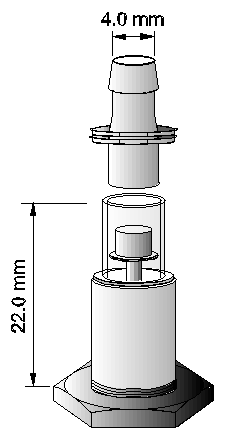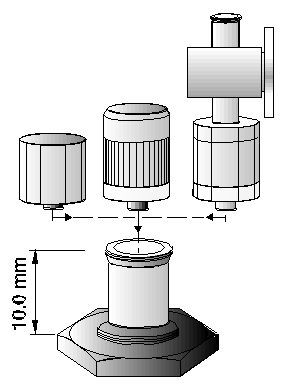Features
- Non-permeable
- Opaque – to protect collected gases against ultraviolet light
- Do not chemically interact with gases
- Strong enough to withstand rough and repeated handling
- Purging possible by use with 2 valves positioned diagonally at opposite side in bag corners
- Withdrawal of gas sample by use of syringe with septum or replaceable septum
- Do not become brittle or otherwise deteriorate over time
- Simple to maintain and do not require technical training to operate
- Virtually unlimited shelf life
Application
RITTER air/gas sampling bags have been specifically designed for easy and reliable collection of air and gas samples. The non-permeable, opaque and chemically inert properties of the bags ensure that the collected gases remain uncontaminated and unaltered. The sampling bags provide a simple and economical method of collecting and transferring air and gas samples from any collection point to a centrally located test instrument or laboratory for analysis. They are, therefore, ideal for use in hard-to-reach locations. The bags can also be used to collect vapours, or may be used with odour test panels. When using gas sampling bags, it may not be necessary to keep track of the precise volume collected or the elapsed time required to obtain the sample. Correct use of the bags results in a collected sample that is representative of the environment or process medium from which it was collected (taken), either as a grab sample or a Time Weighted Average. Further, using sophisticated expensive, real-time gas analysis techniques to establish concentration levels generally means being restricted to one fixed monitoring point. In contrast, totally portable gas sampling bags permit absolute freedom of movement and measurement over a wide area of sample points. Determining if and where a gas or pollution problem exists becomes an easy and inexpensive task.Design
Any gas sampling bag technique is dependent upon the quality of the sampling bag used. The construction and materials of the RITTER Gas Sampling Bags ensure the physical integrity of any sample taken, and allow it to be stored without change over time. Thus, the collected sample remains truly representative of its collection environment or medium conditions. In contrast to common single-layer plastic sampling bags, these silvery bags are made of five different layers of materials:- Polyethylene terephthalate (PET) – 12 μm, outside
- Polyethylene (PE) – 20 μm
- Aluminium – 12 μm
- Oriented Polyamides (OPA) – 15 μm
- Polyethylene (PE) – 80 μm, inside
Pressure & Temperature
The sampling bag inflation pressure need not exceed 0.25 psi (17.4 mbar). Bags should not be over-inflated, as this may lead to bag failure. When bag samples are air transported, provision should be made for gas expansion at higher flight altitudes. Bags should not be used at temperatures higher than 50 °C – 55 °C (125 °F – 130 °F). All polymer based gas sampling bags should be handled with extra care when used at any temperature above ambient, particularly above 40 °C – 45 °C (110 °F – 115 °F). If high-temperature stack gases are to be collected, sample line tubing should be long enough to allow the sampled gas stream to cool before entering the bag.Bag types
RITTER Gas Sampling Bags are available in pillow shape and can be manufactured in the standard sizes up to 60 liters as listed in the table below.| Description | Shape | Volume (1) | Width | Length | |
|---|---|---|---|---|---|
| Gas Sampling Bag GSB-P/ 0.1 | Pillow | 0.1 ltr | 76 mm | 127 mm | |
| Gas Sampling Bag GSB-P/ 0.5 | Pillow | 0.5 ltr | 152 mm | 203 mm | |
| Gas Sampling Bag GSB-P/ 1(2) | Pillow | 1.0 ltr | 203 mm | 203 mm | |
| Gas Sampling Bag GSB-P/ 2 | Pillow | 2.0 ltr | 203 mm | 305 mm | |
| Gas Sampling Bag GSB-P/ 5 | Pillow | 5.0 ltr | 203 mm | 584 mm | |
| Gas Sampling Bag GSB-P/ 10 | Pillow | 10.0 ltr | 381 mm | 406 mm | |
| Gas Sampling Bag GSB-P/ 15 | Pillow | 15.0 ltr | 400 mm | 508 mm | |
| Gas Sampling Bag GSB-P/ 22 | Pillow | 22.0 ltr | 406 mm | 610 mm | |
| Gas Sampling Bag GSB-P/ 44 | Pillow | 44.0 ltr | 584 mm | 660 mm | |
| Gas Sampling Bag GSB-P/ 60 | Pillow | 60.0 ltr | 610 mm | 800 mm |
(2) 1-liter bags vary in shape, will be shipped as available in stock
Standard Valve
If not specified differently, the Gas Sampling Bags will be delivered with standard valve »Twist-Type Double-O-Ring (V-NPB-2/OO)«.
Twist-Type Double-O-Ring (V-NPB-2/OO)
The twist-type valve with hose barb enables a controlled gas flow through continuous rotation of the valve in the closing or opening direction. The notched structure of the hose barb secures and seals the tubing on the valve stem. To open or close the valve, it is turned clockwise or counter-clockwise. The inner double O-ring seals the valve stem both when the valve is open and at any angle of rotation.Optional Valves

Straight Through Connection (STC-NPB-F-SR)
The Straight Through Connection (STC) can be ordered as a standard feature instead of the Twist-Type valve. The Straight-Through Connection (STC) is any unobstructed gas channel connection that does not allow the user to control the flow of gas. Two STC’s may be used to allow a continuous flow of gas or liquid through the bag, if the bag is to be used as a buffer. Used in conjunction with another type of valve (inlet port), an STC may also be installed as an outlet purge-port, so as to permit a flow-through purge (cleaning) of the bag after each use. (In this case, for gas sampling, a short piece of tubing must be placed on the STC and a closing device (such as a plastic medical tubing clamp) then placed on this tubing.)
Luer-Fit Valve™ (V-L/F-1)
The Luer-Fit Valve™ is a secure, self-closing valve which cannot be opened or left open accidentally, thus preventing any loss of gas or liquid sample. It is easy to use and requires no turning or twisting of the valve stem. The Luer-taper Quik-Mate™ Connector (shown above the Luer-Fit Valve™), standard with each Luer-Fit Valve™, is a flow-through adapter for instant (push-pull) connection of tubing to the valve. The tapered fitting between the valve stem housing and Quik-Mate™ Connector becomes tighter as pressure is exerted on the Quik-Mate. This ensures a gas-tight fit between the sample line tubing and the Luer-Fit Valve™. Gases can be inserted or withdrawn through the use of either sample line tubing or a syringe with a Luer-taper barrel fitting. This valve can eliminate the need to work with syringe-needles, if desired.Please Note: Because of its tiny gas channels, the Luer-Fit Valve™ is not suitable for gases containing particles. It also has a lower flow rate than other valve connections at the same pressure. Further, one must be aware of „dead space“ which may occur when using a syringe with a needless syringe barrel, to withdraw or inject sample gas or liquid through the valve-stem housing.

Replaceable Septum Holder (A-SEPHLD/DEL)
When a septum is affixed to a bag with an adhesive, every penetration of it by a syringe makes another hole in the bag. This leads to continued bag deterioration and reduces its useful life. An optional replaceable septum holder allows the user to change the septum as required. Replaceable septum holders are available in the following materials: Delrin, Nickel plated brass, and Polysulfone. Stainless steel is available on special order.
Stopcock-valve
The Stopcock-Valve is one of our most popular valves because of its many different applications. This valve allows the user to control the flow of gas with greater flexibility. It consists of two pieces – a stopcock-base and a stopcock valve assembly which connects independently to the base by means of a rotating locking nut. (Figure – left to right: Closing Cap »STOPCK-DE/1500«, Stopcock-Septum »STOPCK-SEP«, 1-way-Stopcock »STOPCK-ROT/ L1200«).
The base »STOPBASE-F« can also be used as a Straight-Through Connection (STC) simply by attaching tubing using the Quik-Mate™ Connector. The Stopcock Valve (connected to the base by a clockwise twisting motion) is also compatible with all our Luer-taper collection accessories. Tubing can also be easily fitted to the end of the Stopcock Valve using the Quik-Mate™ Connector.
An optional self-sealing Stopcock-Septum, directly connected with a clockwise twisting motion to either the stopcock base alone or to the top of the stopcock-valve assembly, permits direct syringe injection/withdrawal of sample gas or liquid without any dead space effect.

